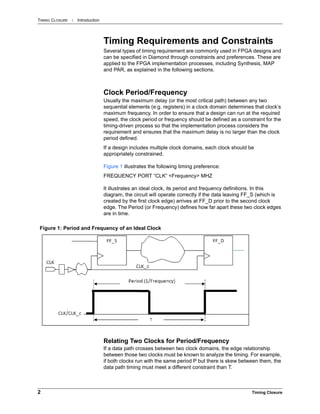

no matter what I do, I can't seem to get the tool the realize that I am trying to constraint the inferred clock that it is complaining about in the.

I've got the syntax above from Synopsys documentation and tried multiple switches with it such as trying to pull the "source" from clock pin etc. Q3: That is what the auto-generated file is for. Then you take the auto-generated SDC from synplify and give it to the compile step, together with a third SDC where you define all input/output delays, false paths, and things like that. fdc file in the form ofĬreate_clock -period $period_48 ] -divide_by 4 Typically you create a SDC file for Synplify, containing basically only clock information.
SYNPLIFY PRO CLOCK CONSTRAINT CODE
I compile the FPGA code using Synplify Pro and my clock constraints are on a. I do not have a way of using a core, pll or any other clock resource (as far as I know) to accomplish this. Application Note Synplify Tool RAM Inferencing Support To infer a RAM, the Synplify synthesis tool lo oks for an assignment to a signal (register in Verilog) that is an array of an array, or a case structure controlled by a clock edge and a write enable.
SYNPLIFY PRO CLOCK CONSTRAINT SOFTWARE
Hope it rrect me if i am wrong.I have a 48Mhz clock coming in to my ProAsic3 FPGA which I divide down using a counter to 12Mhz. RAM Inferencing in Synplify® Software Using Xilinx RAMs Synplicity, Inc. When prompted to save changes you made, click Yes. To close Synplify, from the File menu, choose Exit.

Your changes are saved to the original design file in your project. Double-click the file name in the Synplify window showing the loaded design files. This constraint can be used just for testing without actually instantiationg a DLL.and finally when it works fine u can add the dll.otherwise i don't find any use using this constarint for dll outputs. If errors appear after you click the Run button, use the Synplify editor to edit the file. My problem is that one of the constraints doesnt get propageted to the xdc files included in the dcp. Based on this IP, I then create a dcp file. Then I run the 'Create and Package IP' functinality to create my own IP. Synplify Pro honors the timing constraints according to Precedence Order in Table 1-4. Then I use the Vivado (2014.1) GUI to Add sources and add the edf and the xdc file. Timing Constraints for Synplify Pro Overview Synplify Pro supports the FPGA Design Constraints (FDC) format. constraint with the highest precedenc e and ignores the other timing exce ptions according to the order of precedence shown in Table 1-3. When u use dll for multiplication the derived clk nets doesnot appear in the gui global clock window.u can find the the net name and asisign this constraint.but it is not needed since the same constraint the tool applies for dll outputs u can verify from the place and route report showing all the clock constraints. Microsemi recommends the SDC Timing constraints be used for all tools (Synplify Pro Synthesis, Libero SoC Place and Route and Timing Analysis) to constrain the timing requirements of your design. Wire_clk90 is the 90 degree phase shifted by twice the clkin Here wire_clk90 is derived clock from clkin. TIMESPEC "TS_wire_clk90" = PERIOD "wire_clk90" "TS_clkin" * 2 PHASE + 12.5 ns TIMESPEC "TS_clkin" = PERIOD "clkin" 20 MHz HIGH 50 % Here the clk_1 is the base clock and clk_2_s is the derived clock.clk_2 is half the frequency of clk_1.here clk_2_s is not in the port its an internal clock. TIMESPEC "TS_clk_2_s" = PERIOD "clk_2_s" "TS_clk_1" / 2 PHASE + 0 ns TIMESPEC "TS_clk_1" = PERIOD "clk_1" 20 MHz HIGH 50 %


 0 kommentar(er)
0 kommentar(er)
